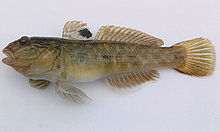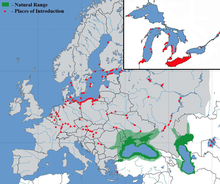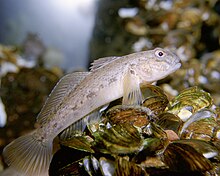Round goby
| Round goby | |
|---|---|

| |
| Scientific classification | |
| Domain: | Eukaryota |
| Kingdom: | Animalia |
| Phylum: | Chordata |
| Class: | Actinopterygii |
| Order: | Gobiiformes |
| Family: | Gobiidae |
| Genus: | Neogobius |
| Species: | N. melanostomus
|
| Binomial name | |
| Neogobius melanostomus (Pallas, 1814)
| |

| |
| Range of the round goby and introduction sites | |
| Synonyms[2][3] | |
| |
The round goby (Neogobius melanostomus) is a euryhaline bottom-dwelling species of fish of the family Gobiidae. It is native to Central Eurasia, including the Black Sea and the Caspian Sea. Round gobies have established large non-native populations in the Baltic Sea, several major Eurasian rivers, and the North American Great Lakes.[4]
Characteristics
Round gobies are small, soft-bodied fish characterized by a distinctive black spot on the first dorsal fin. The eyes are large and protrude slightly from the top of the head and, like most gobies, the pelvic fins are fused to form a single disc (shaped like a suction cup) on the belly. Round gobies range in length from 10 to 25 centimetres (4 to 10 inches), with a maximum size of 24.6 cm (9.7 in). They weigh between 5.0 and 79.8 grams (0.176 and 2.816 ounces), their weight increasing with age. Male round gobies are larger than females. Juvenile round gobies (less than one year old) are grey. Upon maturation, round gobies become mottled with grey, black, brown, and olive green markings. Adult male round gobies turn inky black during the spawning season and develop swollen cheeks. Male and female round gobies are easily differentiated by the shape of their urogenital papilla, which in males is white to grey and long and pointed and in females is brown, short, and blunt-tipped. [citation needed]
Distribution and habitat
Round gobies are widespread in the
Since 1990, the round goby has been registered as
Round gobies are euryhaline (salt-tolerant) and live in both freshwater and marine ecosystems, up to a mineralization of 18–24%. They are commonly found on continental shelves with sandy and rocky bottoms with low silting at depths from 1–2 m (3.3–6.6 ft) to 10–17 m (33–56 ft).
Feeding
Round gobies actively feed both
In the
Reproduction

Female round gobies reach sexual maturity in one to two years while males do so in three to four years. Gobies in the
Males will migrate from deeper water, where overwintering occurs, into shallower breeding grounds during the beginning of the mating season. They then release a steroid sex pheromone that attracts females to their territory. Males also use visual displays, including posturing and changing color from beige to black during mating season, and can produce sounds during courtship. The females deposit their eggs in male-guarded crevices between rocks. Eggs are 4 by 2.2 mm (0.16 by 0.087 in) in size, while egg clutches can contain up to five thousand eggs. Males are territorial and will defend eggs from predators as well as continuously fan them to provide the developing embryos with oxygenated water. This results in successful hatch rates of up to 95%.
Invasive species

The species was accidentally introduced into the North American Great Lakes by way of ballast water transfer in cargo ships. First discovered in North America in the
Many native predatory fish such as
The round goby is also considered invasive in parts of Europe. This process was started by its introduction to the Gulf of Gdańsk (southern Baltic Sea) in 1990.[15] Locations recently invaded by round gobies include the Aegean Sea,[16] different parts of the Baltic Sea,[17] the North Sea basin,[18] and the Danube and Rhine basins.[19][20] In the German part of the Baltic Sea this fish was first noted near Rügen Island.[21] It is now distributed all along the southwestern Baltic Sea coast, including Stettiner Haff (Szczecin Lagoon), the Unterwarnow (Warnow river estuary), the mouth of the Trave, and the Nord-Ostsee (Kiel) Canal.
As of 2010, the westernmost site of round goby occurrence in Europe was the lower
Parasites
In total, fifty-two
In the Gulf of Gdańsk, Baltic Sea, the parasites of the invasive round goby consist of twelve species.
Twenty-five species of parasites are noted in the round goby in the American Great Lakes.
References
- . Retrieved 31 July 2023.
- ^ "Neogobius melanostomus (Pallas, 1814)". Global Biodiversity Information Facility. Retrieved 31 July 2023.
- ISBN 978-954-9746-29-7. Retrieved 31 July 2023.
- ^ PMID 22268429.
- doi:10.1139/f92-047.
- OCLC 38041117.
- flatfishes, : Naukova Dumka, 320 pp. (in Russian)
- ^ Porumb I.I. (1961) Contribuţii la cunoşterea biologiei guvisilor (Gobius batrachocephalus, Gobius cephalarges şi Gobius melanostomus) din dreptul litoralului Romînesc al Mării Neagre (date preliminare), Hidrobiologia, 3, 271–282.
- ^ Khirina V.A. (1950) Materialy po pitaniju nekotoryh bentosnyh ryb v pribrezhnoj zone Chernogo moria u Karadaga. Trudy Karadagskoy biologicheskoy stantsii, No 10: 53–65.
- ^ Kvach, Y.; Zamorov, V. (2001). "Feeding preferences of the round goby Neogobius melanostomus and mushroom goby Neogobius cephalarges in the Odessa Bay". Oceanological Studies. 30 (3–4): 91–101.
- S2CID 24355546.
- ^ Lydersen, Karl (May 26, 2011). "The Round Goby, an Uninvited Resident of the Great Lakes, Is Doing Some Good". The New York Times. Retrieved May 27, 2011.
their ecological impact has not been devastating, but complicated — even beneficial in some cases.
- ^ Williams, Rebecca (producer). "Ten Threats: Natives Bite Back". The Environment Report, October 10, 2005. Accessed 11 February 2010.
- S2CID 40123286.
- ^ Skóra K.E., Stolarski J. (1993) New fish species in the Gulf of Gdańsk Neogobius sp. [cf. Neogobius melanostomus (Pallas 1811)]. Bull. Sea Fisheries Inst., 1(128): 83.
- ^ Eryilmaz L. (2002) A new fish record for the Aegean Sea: round goby Neogobius melanostomus (Pallas, 1814) (Gobiidae). Israel J. Zool., 48: 251–252.
- S2CID 12882124.
- .
- .
- .
- ^ Winkler, H.M. (2006). "Die Fischfauna der südlichen Ostsee". Meeresangler-Magazin. 16: 17–18.
- .
- ^ Manné S.; Poulet N.; Dembski S. (2013). "Colonisation of the Rhine basin by non-native gobiids: an update of the situation in France" (PDF). Knowledge and Management of Aquatic Ecosystems. 411 (2).
- ^ Kvach Y. (2002). "Round goby's parasites in native habitats and in a place of invasion". Oceanological Studies. 31 (1–2): 51–57.
- .
- ^ Youssef M.M.; Mansour N.S.; Awadalla H.N.; Hammouda N.A.; Khalifa R.; Boulos L.M. (1987). "Heterophyid parasite of man from Idku, Maryat and Manzala Lakes areas in Egypt". J. Egypt. Soc. Parasitol. 17: 474–479.
- PMID 19312928.
- ^ Kovalenko I.I. (1960) "Izucenie cikla razvitiâ nekotoryh gel’mintov domasnih utok v hozâjstvah na Azovskom poberez’e". Doklady AN SSSR, 133(5): 1259–1261. (In Russian)
- S2CID 2945139.
- ^ Kvach Y. (2004). "The Far-Eastern nematode Anguillicola crassus – new parasite of the invasive round goby Neogobius melanostomus in the Baltic Sea". Vestnik Zoologii. 38 (2): 38.
- ^ Rolbiecki L. (2006). "Parasites of the round goby, Neogobius melanostomus (Pallas, 1811), an invasive species in the Polish fauna of the Vistula Lagoon ecosystem" (PDF). Oceanologia. 48: 545–561.
- ^ Camp J.W.; Blaney L.M.; Barnes D.K. (1999). "Helminths of the round goby, Neogobius melanostomus (Perciformes: Gobiidae), from Southern Lake Michigan, Indiana" (PDF). J. Helminthol. Soc. Wash. 66: 70–72.
- ^ Muzzall P.M.; Peebles C.R.; Thomas M.V. (1995). "Parasites of the round goby, Neogobius melanostomus, and tubenose goby, Proterorhinus marmoratus (Perciformes: Gobiidae), from the St. Clair River and Lake St. Clair, Michigan" (PDF). J. Helminthol. Soc. Wash. 62 (2): 226–228.
- PMID 9229568.
- S2CID 54784967.
- .
External links
- Round Goby, an invasive species in the Great Lakes
- Aquatic Invasive Species - Minnesota Sea Grant Archived 2017-01-03 at the Wayback Machine
- Global Invasive Species Database
- Harmful Aquatic Hitchhikers
- Minnesota DNR
- InvadingSpecies.com, Ontario Ministry of Natural Resources and Ontario Federation of Anglers and Hunters
- USGS Non-indigenous species
- Species Profile - Round Goby (Neogobius melanostomus), National Invasive Species Information Center, United States National Agricultural Library. Lists general information and resources for Round Goby.
- University of Michigan Museum of Zoology. Animal Diversity Web. Neogobius melanostomus.
- GLANSIS Species Fact Sheet, United States Geological Survey

